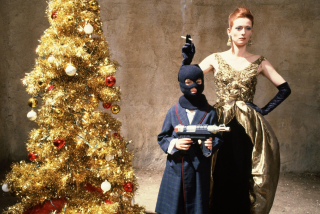‘NAKED EYE’ TURNED ON PHOTOGRAPHY
- Share via
In his graceful 71-minute, Oscar-nominated 1956 documentary “The Naked Eye,” which Filmforum presents tonight at 7:30 at the Wallenboyd (301 N. Boyd St.), Louis Stoumen gives us a succinct survey of the history of photography.
After acknowledging the pioneers, he concentrates on three wildly different photographers: Life magazine’s Alfred Eisenstaedt, who became as famous as his subjects; nature specialist Edward Weston, who receives the major emphasis, and Weegee.
Yes, Weegee, whose real name was Arthur Felig and whose specialty was covering Manhattan at night. The stocky, cigar-chomping, Runyon-esque Weegee (1899-1968) lived in a tiny combination bedroom-darkroom off Times Square and roamed the city, with regular rounds of the Bowery and police stations. He photographed strip-tease queens in action, murder victims, fires--anything that caught his eye. His subjects often may have been lurid and sensational, but Weegee, whose influence on Diane Arbus is unmistakable, combined detachment and sensitivity in a way that has made his work enduringly disturbing rather than merely exploitative. Stoumen includes one of his most famous pictures, that of elderly grande dame Mrs. George Washington Kavanagh, and an equally bespangled friend arriving at the opera, sublimely oblivious of the street woman heckling them. The Polish-born Weegee’s book “Naked City” inspired the classic Jules Dassin film and subsequent TV series. Along with “The Naked Eye,” the Filmforum will screen Weegee’s own 20-minute “Weegee’s New York” (1948), which was not available for preview. Stoumen, a UCLA professor as well as a film maker and photographer, will be present. Information: (213) 276-7452.
The unjustly neglected “Go Tell the Spartans” (Tuesday only at the Nuart) is a terse, acrid account of the early days of our involvement in Vietnam. Adapted by Wendell Mayes from Daniel Ford’s novel “Incident at Muc Wa” and directed by Ted Post, this 1978 film encompasses all that was to go wrong in Vietnam, starting with our ill-advised involevment in the first place. Burt Lancaster, who stars as crusty professional soldier, has a comic anecdote that is in itself a classic screen moment. Information: (213) 478-6379, 479-5269.
“Before Snow White (And After): Mickey Mouse and the Silly Symphonies” continues at the County Museum of Art’s Bing Theater on Friday (at 1 and 8 p.m.) and Saturday (10 a.m. and 8 p.m.), with two different programs of Disney shorts made between 1932 and 1936. To see a selection of these films is to be enchanted--even if you’ve never been a cartoon fan. How refreshing they are in comparison with the cartoons of the 657731699greatly enhanced with the advent of three-strip Technicolor, is as much a part of vintage Americana as the illustrations of Maxfield Parrish and Norman Rockwell.
The programs include cartoons as famous as “The Three Little Pigs” and some that surely are known only to animation historians. Along with original material, Disney drew from the classic children stories and literature. Some of the most delightful are the ones that are the most topical: in Disney’s retelling of “Who Killed Cock Robin?,” the ill-fated hero is given a Bing Crosby voice and his girlfriend is an amusing and accurate parody of Mae West.
“Mickey’s Polo Team” includes no less than characterizations of Stan Laurel, Oliver Hardy, Harpo Marx and Charlie Chaplin; cheering on their shenanigans from the stands are Garbo, Gable, W. C. Fields and Shirley Temple.
One of the most unusual and ambitious films is “The Goddess of Spring,” a mini-opera of gossamer kitsch in which our Snow White/Cinderella-like goddess is abducted by no less than the Devil, erupting from a volcano. The Devil at last is willing to free the goddess, provided that she return regularly, thus creating the seasons.
“Before Snow White (and After),” which surveys Disney shorts from 1922 to 1956, continues Fridays and Saturdays through June 27. Information: (213) 857-6010.
More to Read
Only good movies
Get the Indie Focus newsletter, Mark Olsen's weekly guide to the world of cinema.
You may occasionally receive promotional content from the Los Angeles Times.










